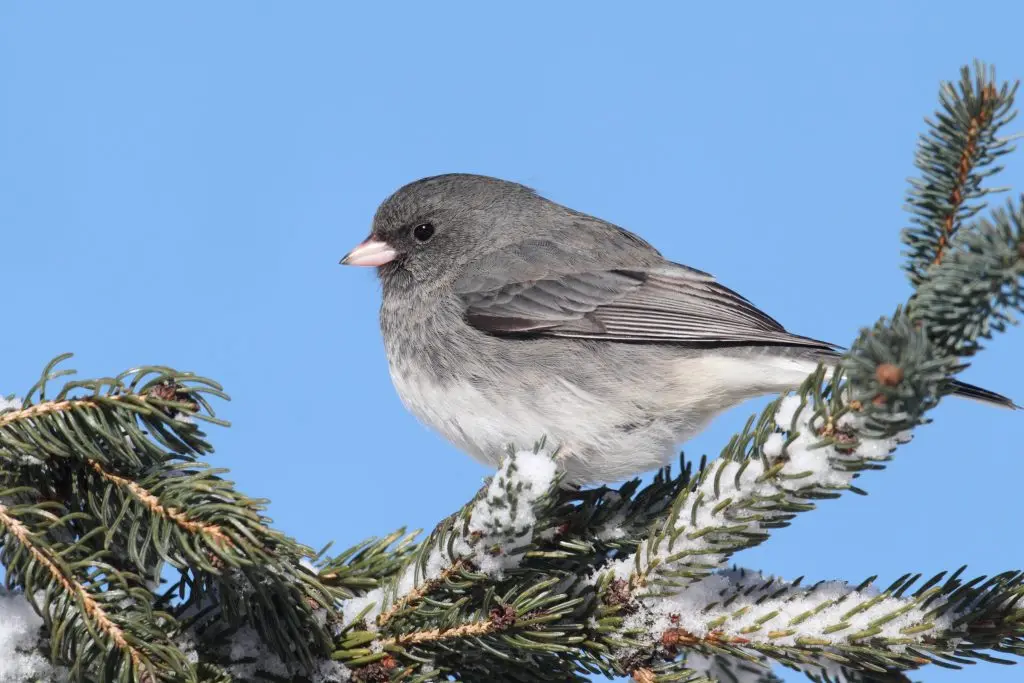
Learn to recognize many of the common backyard birds of the Pacific Northwest with this picture and identification guide.
Print out a picture ID guide for each of the states in the Pacific Northwest for Oregon, Washington, Idaho, and the Canadian Province of British Columbia.
If you are wondering what those birds are that are visiting your backyard or if you need help identifying common birds in then read on to find out more.
34 Backyard Birds in the Pacific Northwest:
1. American Robin
2. Song Sparrow
3. American Crow
4. Northern Flicker
5. Dark-eyed Junco
6. European Starling
7. American Goldfinch
8. Spotted Towhee
9. Red-winged Blackbird
10. Black-capped Chickadee
11. Barn Swallow
12. White-crowned Sparrow
13. House Sparrow
14. House Finch
15. Cedar Waxwing
16. Swainson’s Thrush
17. Red-breasted nuthatch
18. Anna’s Hummingbird
19. Chestnut-backed Chickadee
20. Pine Siskin
21. Yellow-rumped Warbler
22. Yellow warbler
23. Western Meadowlark
24. Chipping Sparrow
25. House Wren
26. Mourning Dove
27. Downy Woodpecker
28. Golden-crowned Kinglet
29. Golden-crowned Sparrow
30. Lesser goldfinch
31. Ruby-crowned Kinglet
32. Steller’s Jay
33. Common Yellowthroat
34. Western Tanager
34 Backyard Birds in the Pacific Northwest:
1. American Robin
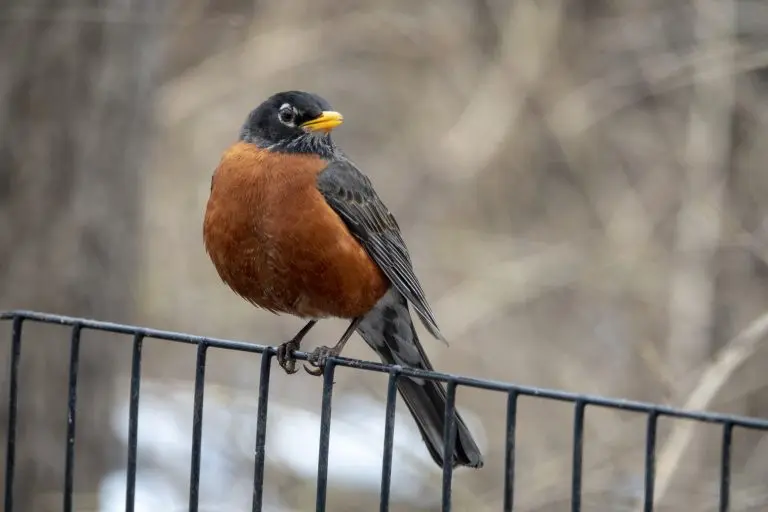
American Robins are a common sight on lawns eating earthworms. They have black heads and back with red or orange breasts. They tend to roost in trees in winter, so you are more likely to see them in your backyard from spring.
American Robins are found in many habitats, from woodlands, forests, and mountains to fields, parks, and lawns. They eat earthworms, insects, snails, and fruit.
You can attract more American Robins to your yard with sunflower seeds, suet and peanut hearts, fruit, and mealworms. Platform feeders are best or food scattered on the ground. Also, try planting some native plants that produce berries, such as juniper, sumac, hawthorn, and dogwood.
2. Song Sparrow
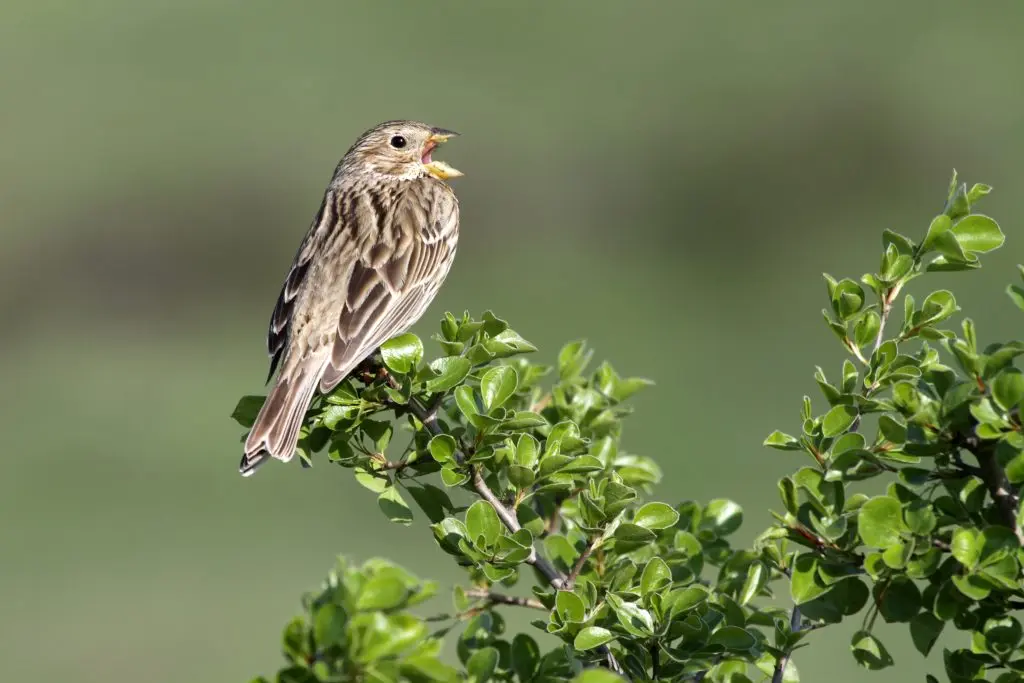
Song sparrows are not as remarkable as other backyard birds, but these predominantly brown-streaked birds use their almost constant song to attract mates in spring and summer.
They can be found in open, shrubby, and wet areas, often perched on a low shrub singing. They are usually found at backyard feeders. Song Sparrows eat a wide variety of insects and plants, including beetles, caterpillars, midges, spiders, and earthworms. They will also eat buckwheat, sunflower, raspberries, wild cherries, blackberries, wheat and, rice.
You can attract more song sparrows to your backyard feeders by putting black oil sunflower seeds, cracked corn, and nyjer on platform feeders.
3. American Crow
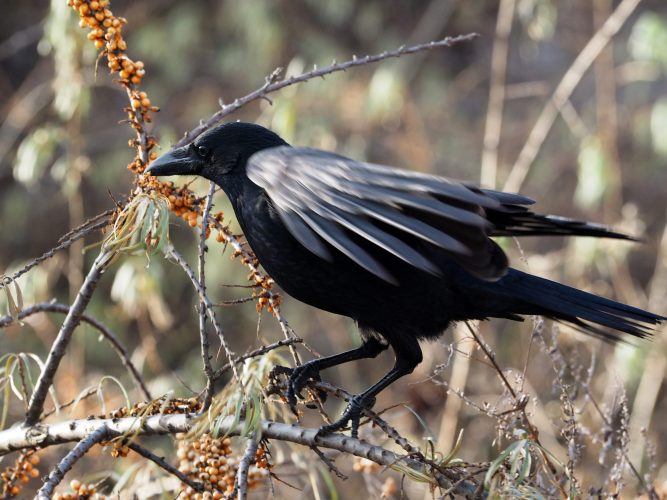
American crows are large all-black birds that make a hoarse, cawing sound. They are common birds that can be found in most habitats, including treetops, woods, fields, beaches, or towns.
They eat most things and usually feed on the ground, eating earthworms, insects, seeds, and fruit. They also eat fish, young turtles, mussels, and clams and will even eat eggs and nestlings of many species of birds.
American Crows gather in large numbers of up to two million crows in winter to sleep in communal roosts.
You can attract more American Crows to your backyard by scattering peanuts but can become a nuisance as attracted by garbage or pet food if left out.
4. Northern Flicker
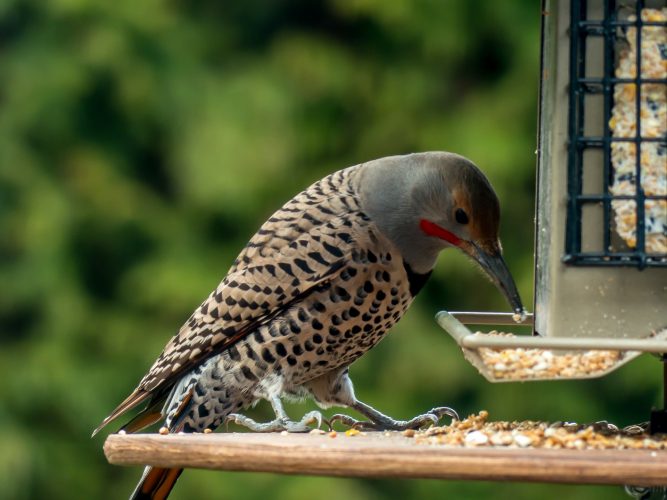
Northern Flickers are large woodpeckers, between the size of a robin and a crow, with brownish coloring and black spots, bars, and crescents and red on the nape. The undersides of tail and wing feathers are bright yellow in eastern birds and red in western birds.
They can be found on the ground looking for ants and beetles in woods or forest edges. Those that breed in Canada or Alaska migrate to southern states, but otherwise, they can be found all year over the lower 48.
You can attract more Northern Flickers to your backyard feeders with suet and black oil sunflower seeds.
5. Dark-eyed Junco
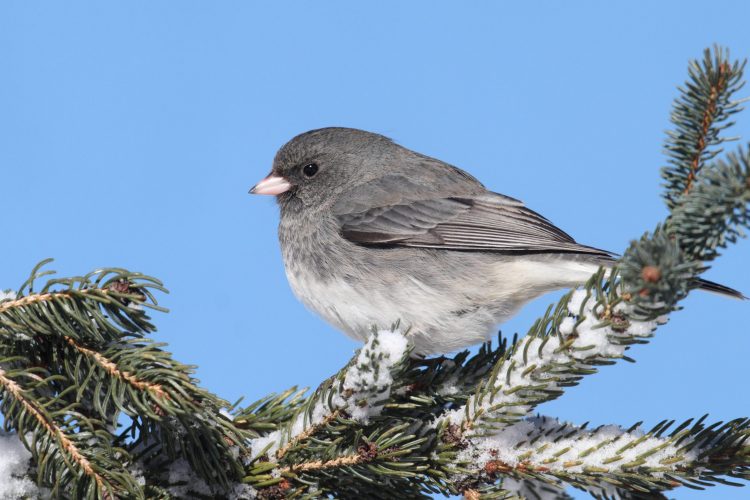
Dark-eyed Juncos are sparrows that are different colors depending on the state. They are generally slate-colored in the east and black, white, and brown in the west.
They can be found in open and partially wooded areas, often on the ground, and are common across the continent. Some remain resident all year in the west and the Appalachian Mountains. Those that breed in Canada and Alaska migrate south in winter to the United States.
You can attract more Dark-eyed Juncos to backyard feeders with a variety of seeds such as black oil sunflower seeds, nyjer, cracked corn, millet, and peanuts. Platform feeders or scattered on the ground are best.
6. European Starling
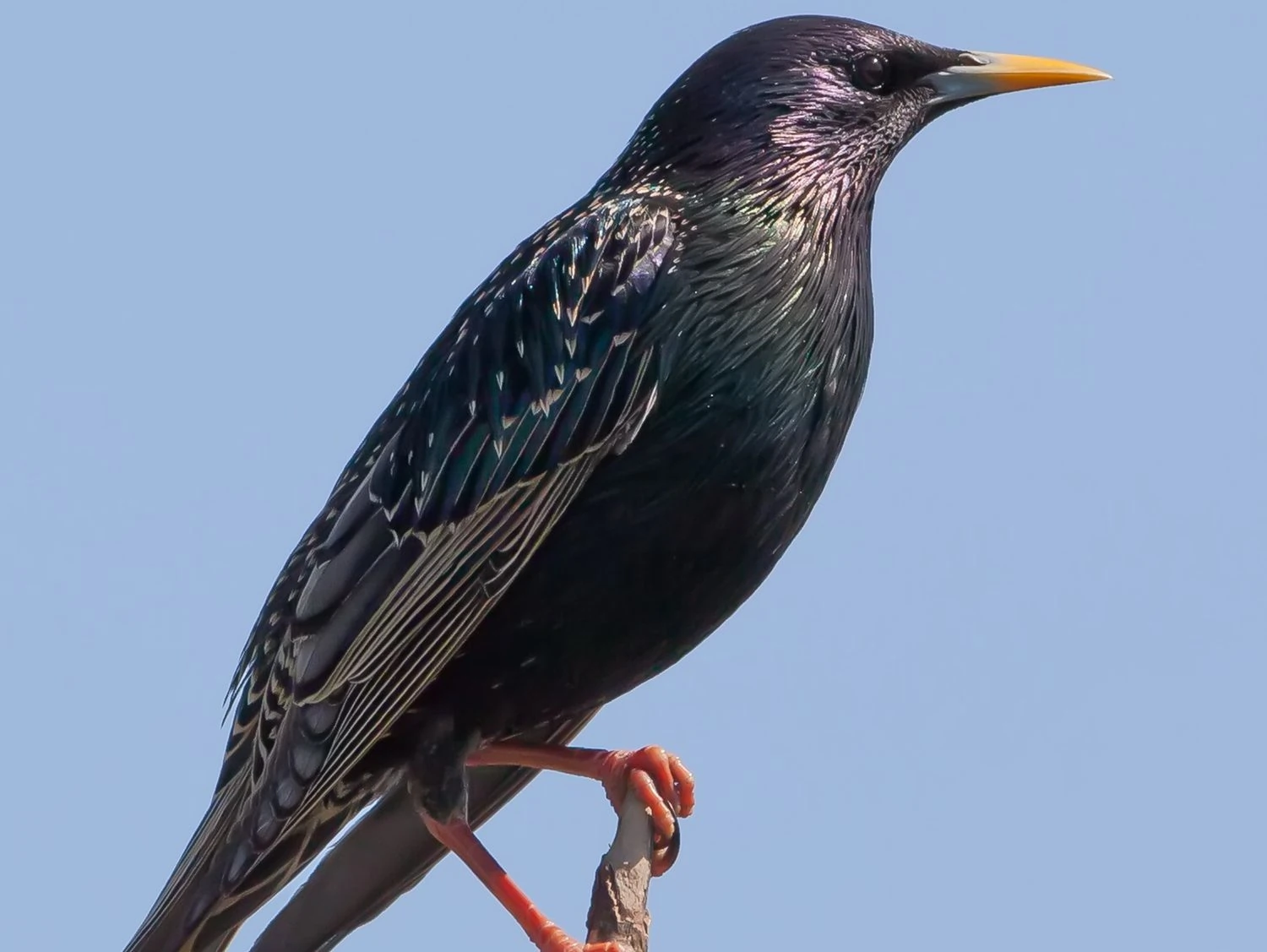
European Starlings are not native but are now one of the most numerous songbirds. They are stocky black birds with iridescent purple, green, and blue tones.
They are considered a pest by some due to their aggressive behavior. These birds fly in large, noisy flocks and can be seen perched in groups on the top of trees or flying over fields in flocks.
Starlings eat insects, including beetles, flies, caterpillars, earthworms, and spiders predominantly. They also eat fruit, including cherries, holly berries, mulberries, Virginia Creeper, sumac, blackberries, and grains and seeds.
You can attract more European Starlings to your backyard feeders with black oil sunflower seeds, suet, cracked corn, and peanuts.
7. American Goldfinch
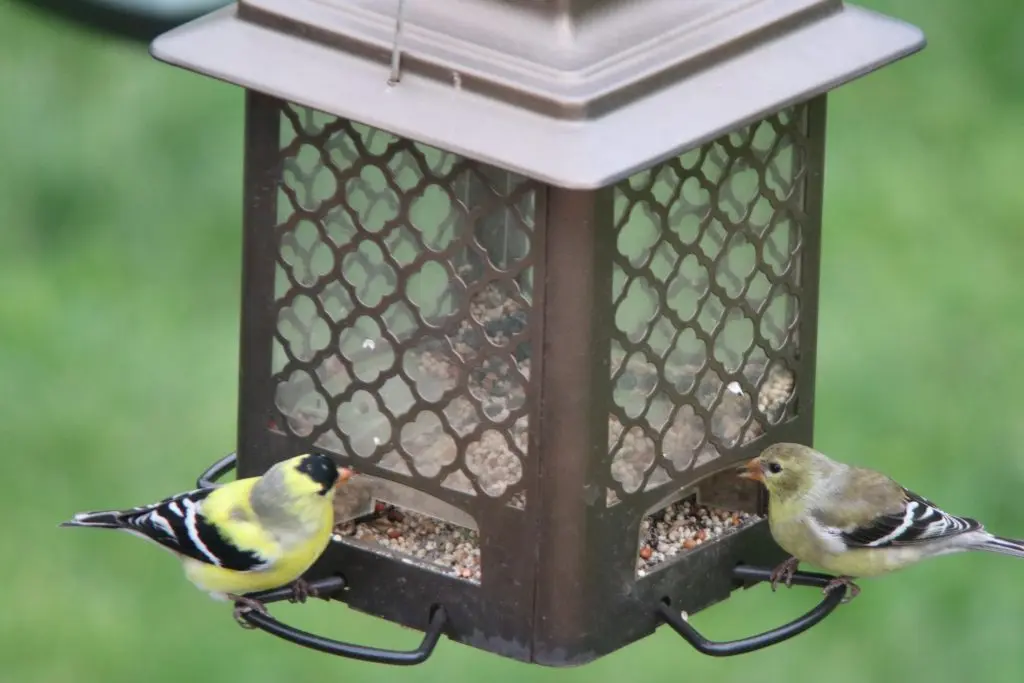
American Goldfinches are popular birds with the males bright yellow and black coloring in spring. The females are duller brown, as are males in winter.
American Goldfinches breed in far northern states and Canada before migrating to southern states. They remain all year in the rest of the U.S.
They can be found in weedy fields and overgrown areas foraging for sunflower, thistle, and aster plants. They are also common in suburbs, parks, and backyards.
To attract more American Goldfinches to your backyard, try planting thistles and milkweed. They will visit most bird feeders and prefer sunflower seed and nyjer seed.
8. Spotted Towhee
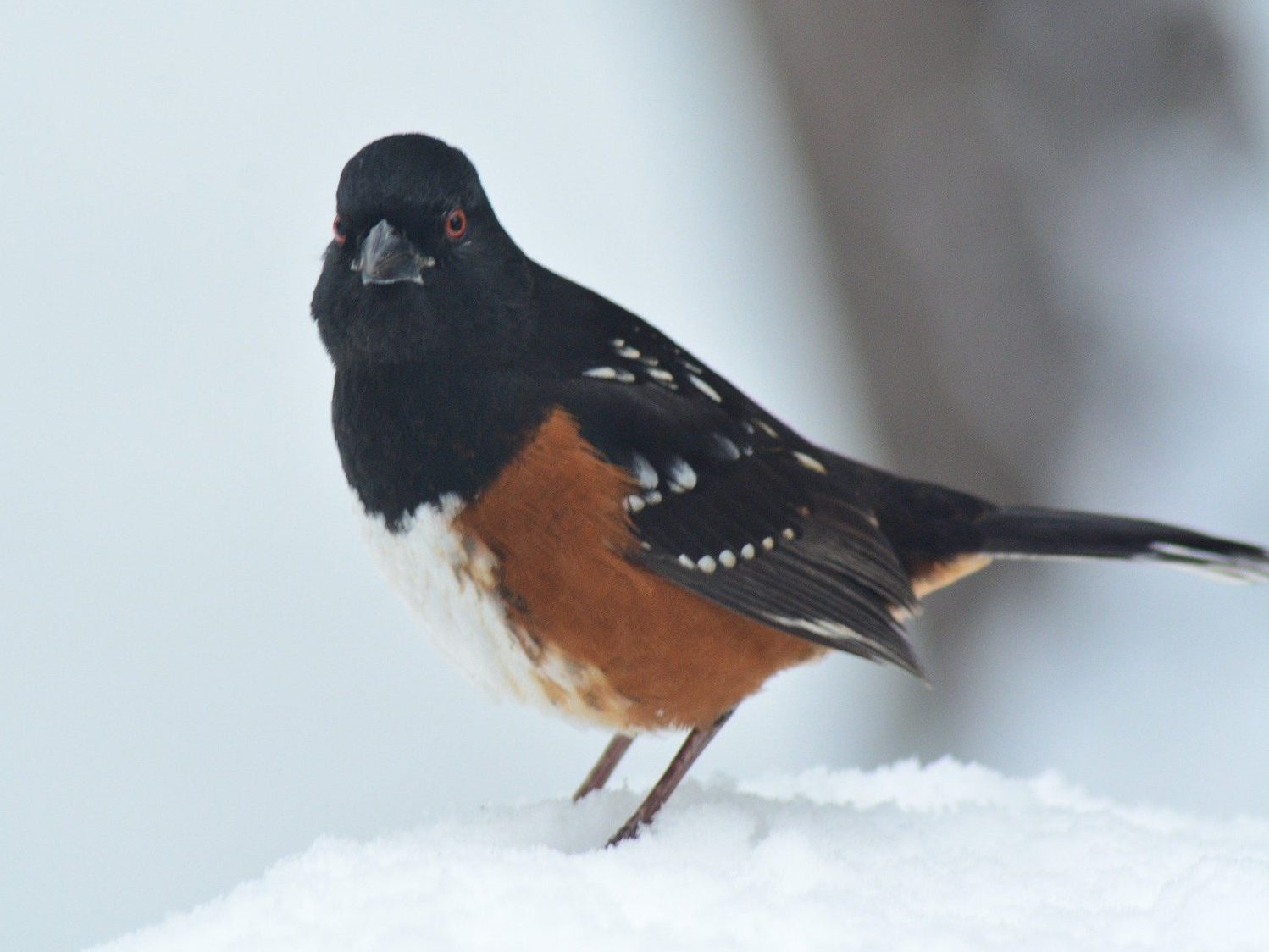
Spotted Towhees are large sparrows that are black on the head, throat, and back in the males and brown in the females. Both males and females have reddish-brown sides and white bellies, and white spots on the wings and back. They have long tails and are about the size of a Robin.
Spotted Towhees can be found on the ground in dense tangles of shrubs scratching around for insects, including beetles, crickets, grasshoppers, caterpillars, wasps, and bees. They also eat acorns, berries, and seeds.
They are resident on the Pacific coast but migrate from northern central states after breeding and appear in winter in a swath from north to south across all central states.
You can attract more Spotted Towhees to your yard if you leave overgrown borders, and they will visit platform feeders or ground feeders for Black Oil Sunflower seeds, Hulled Sunflower seeds, Cracked Corn, Millet, and Milo.
9. Red-winged Blackbird
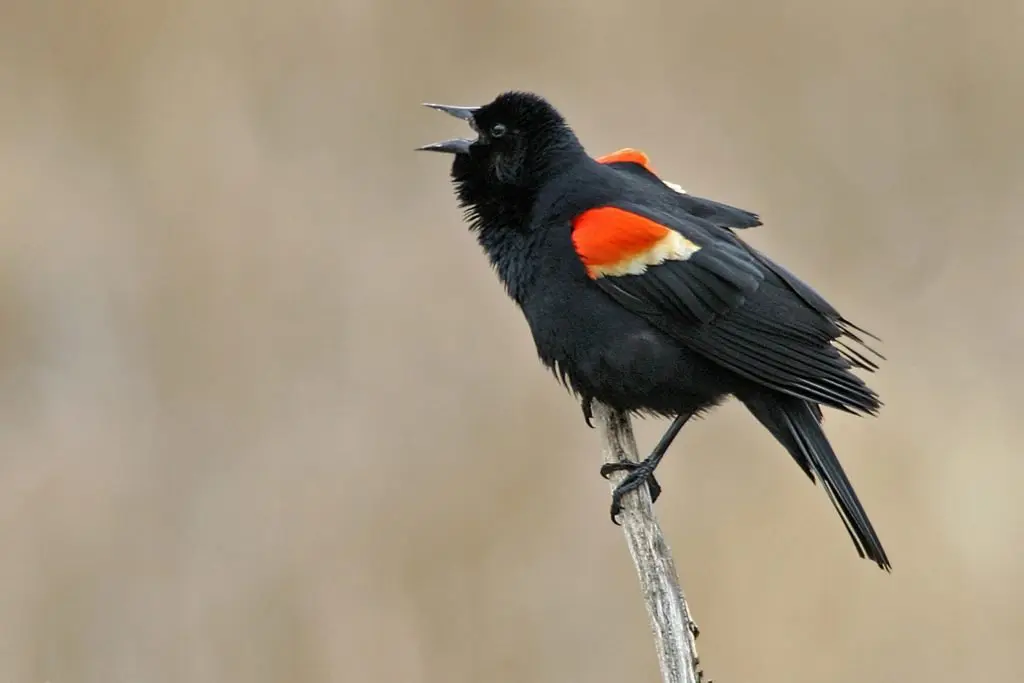
Red-winged blackbirds are very common and easy to identify with the all-black coloring except for the bright red and yellow shoulder patches. The females are rather dull in comparison with streaky brown color.
They can often be spotted sitting on telephone wires, and the males will fiercely defend their territories in the breeding season, even attacking people that get too close to nests. In winter, they roost in large numbers into the millions.
To attract more Red-winged blackbirds to your backyard, try mixed grain and seeds spread on the ground. They will also feed on large tube feeders or platform feeders.
10. Black-capped Chickadee
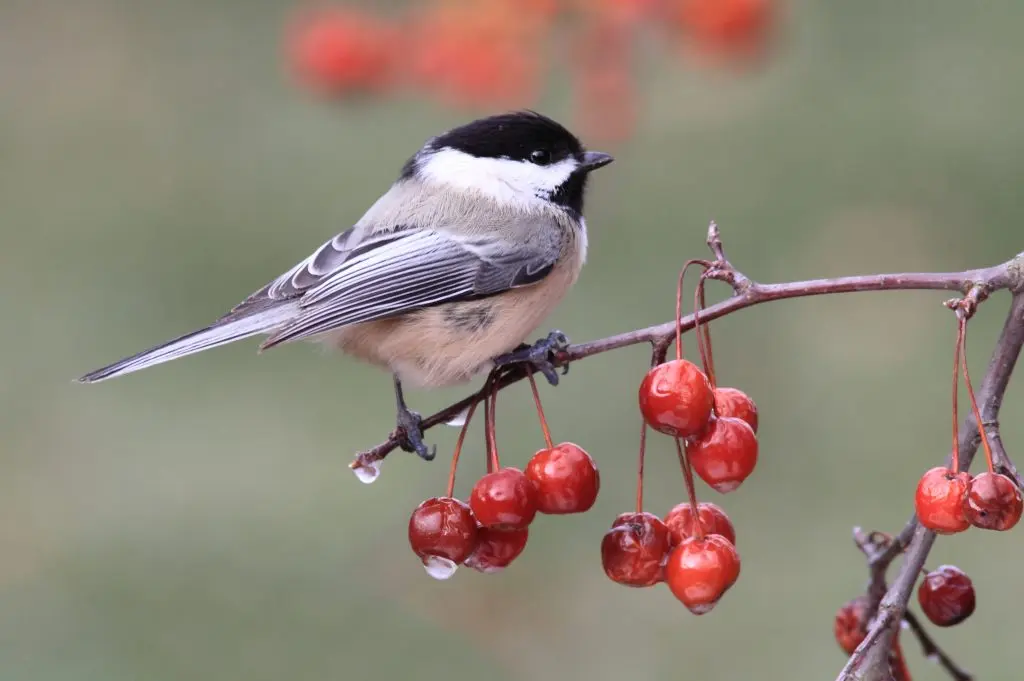
The Black-capped Chickadee is a cute bird with a big round head and tiny body. These birds will happily feed at backyard feeders and will investigate everything, including you!
They have black caps and beaks, white cheeks, and are gray on the back, wings, and tail.
They can be found in forests, open woods, parks. Black-capped Chickadees eat seeds, berries and insects, spiders, and suet.
To attract more Black-capped Chickadees to your backyard, try suet, sunflower seeds, and peanuts or peanut butter. They will even feed on your hand and are often one of the first birds to discover new feeders. They will also use nest boxes, especially if you fill them with wood shavings.
11. Barn Swallow
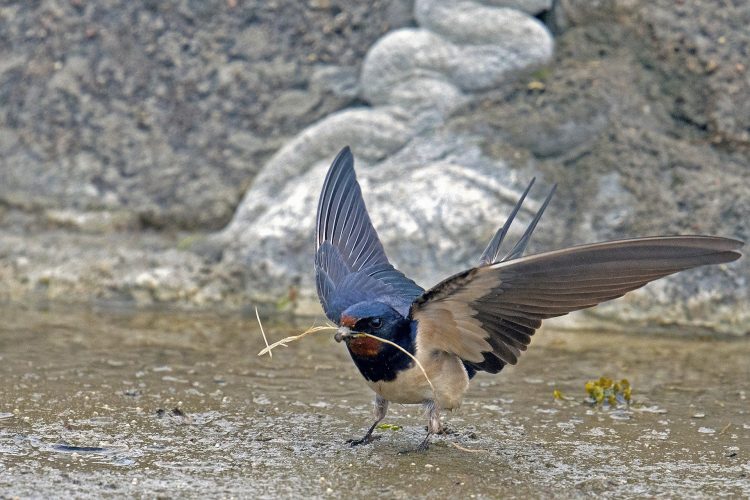
Barn Swallows are small birds with a deep-blue back, wings and tail, and reddish-brown underneath and across the face. The tail has long outer feathers that give a deep fork.
They breed over most of North America before heading to Central and South America. They can be found flying over meadows, farms, and fields looking for insects and usually build mud nests on artificial structures such as in barns.
You can attract more Barn Swallows by putting up nest boxes or cups and may eat ground-up eggshells on a platform feeder.
12. White-crowned Sparrow
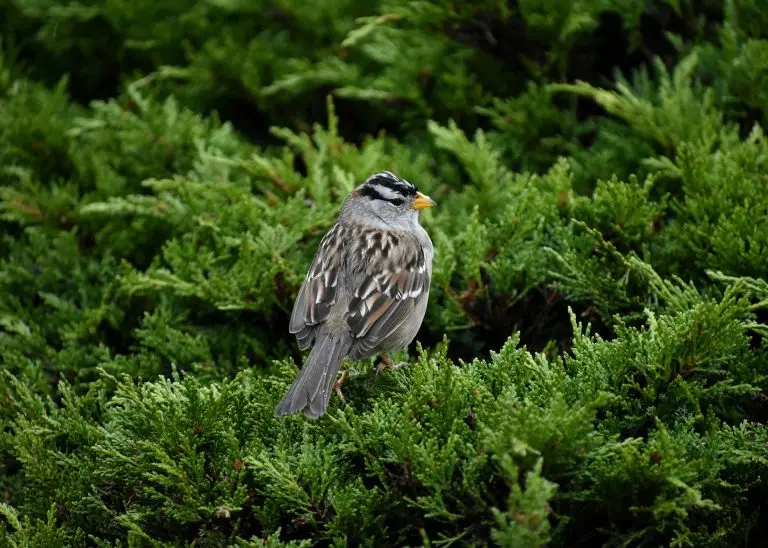
White-crowned Sparrows are large grayish sparrows with long tails and small bills and bold black and white stripes on their heads.
They breed in Alaska and arctic Canada before heading south other much of the lower 48 and Mexico for winter. Some may remain all year over a small area along the Pacific Coast and west.
White-crowned Sparrows can be found in weedy fields, along roadsides, forest edges, and in yards foraging for seeds of weeds and grasses or fruit such as elderberries and blackberries.
You can attract more White-crowned Sparrows to your backyard with sunflower seeds and many types of seeds that are dropped by other birds at the feeders.
13. House Sparrow
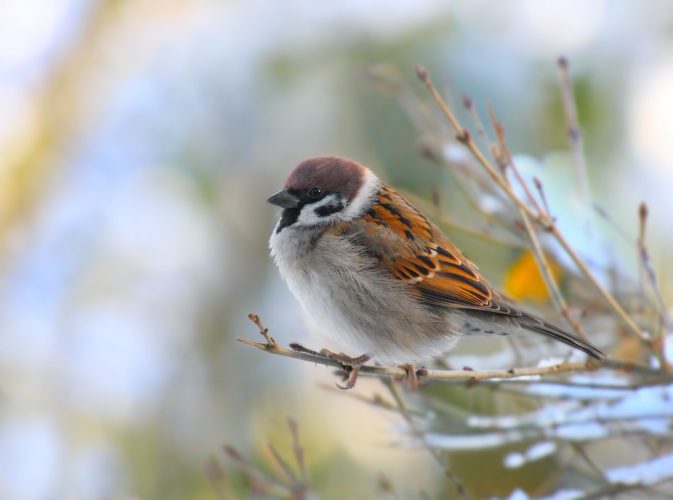
The House Sparrow is another introduced species that has done very well and is now one of the most common birds. They are found near houses and buildings and can be quite tame, so they may eat out of your hand.
They can be considered a pest as they are non-native but will be found in backyards even if you do not feed them. House Sparrows can be found in most busy areas, especially around cities, towns, farms, or anywhere there are people. They eat mostly grain and seed as well as discarded food.
You can attract more House Sparrows to your backyard feeders with most kinds of birdseed, including millet, corn, and sunflower seeds.
14. House Finch
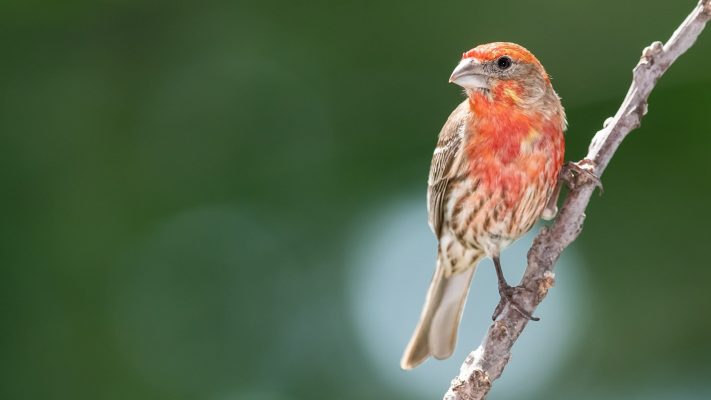
House Finches have a red head and breast in the males and brown-streaked coloring in the females. Originally only in western states, it was introduced to the eastern states and has done very well, even pushing out the Purple Finch.
They can be found in parks, farms, forest edges, and backyard feeders. They can be found in noisy groups that are hard to miss.
You can attract more House Finches to backyard feeders with black oil sunflower seeds or nyjer seeds in tube feeders or platform feeders.
15. Cedar Waxwing
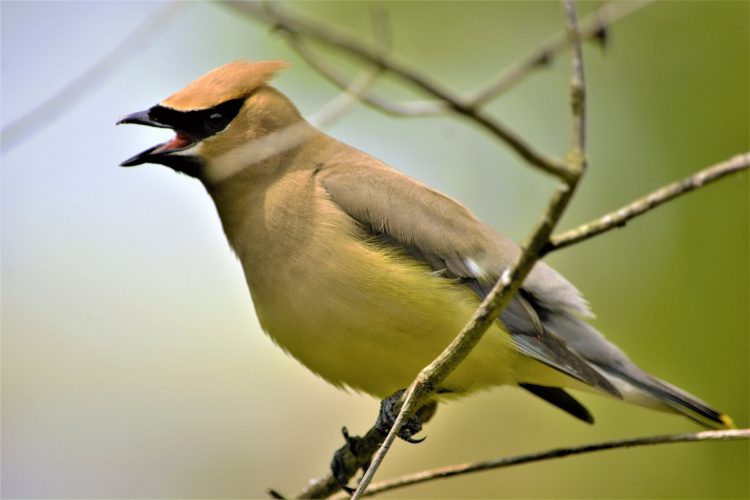
Cedar Waxwings are elegant social birds that are pale brown on the head, chest, and crest, which fades to gray on the back and wings and tail. Their belly is pale yellow, and there is bright yellow on the tip. They have a narrow black mask over their eyes and bright red on the wingtips.
They are resident all year in northern states and in the winter in the south. They make a high-pitched call and can be found in berry bushes, in woodlands, and along streams.
To attract Cedar Waxwings to your backyard, plant native trees and shrubs with small fruit such as serviceberry, dogwood, juniper, winterberry, and hawthorn. You can also try fruit on platform feeders.
16. Swainson’s Thrush
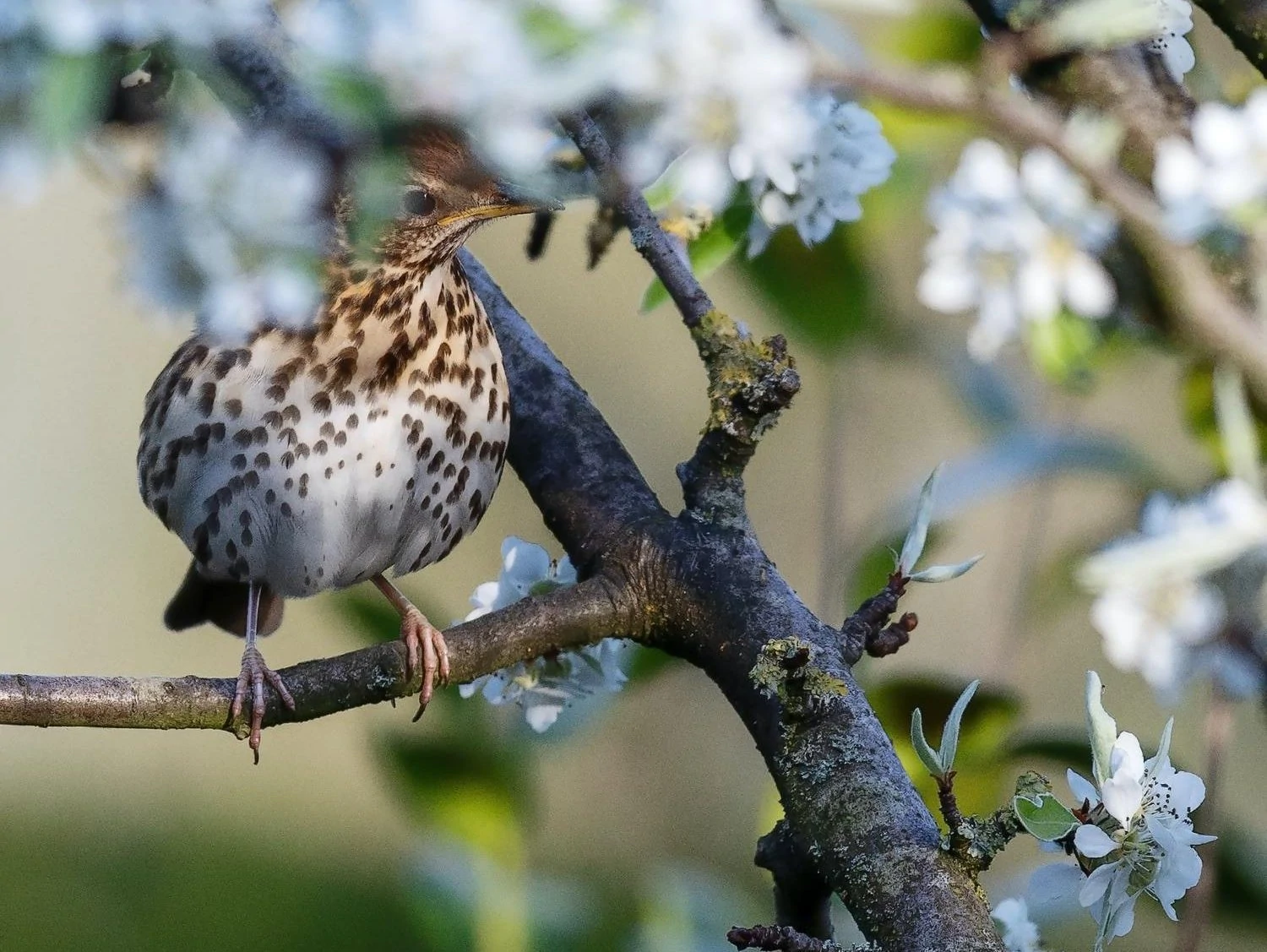
Swainson’s Thrushes are medium-sized thrushes that are pale underneath with spotted chests and brown on the back.
Swainson’s Thrushes can be found in forests foraging along the floor in leaf litter for insects in the breeding season and predominantly red fruits such as blackberries, raspberries, huckleberries, and sumac. Ants also make up part of their diet, and other insects will be fed to nestlings.
Usually only seen during migration, during spring and fall, in the lower 48, Swainson’s Thrushes breed in Canada and Alaska before heading into Central and South America for winter.
You can attract more Swainson’s Thrushes to your backyard with ground-level birdbaths and by providing tree and shrub cover.
17. Red-breasted nuthatch
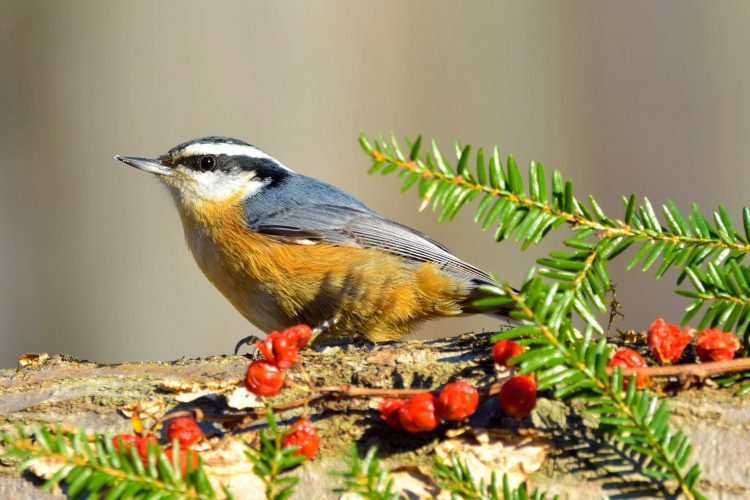
Red-breasted Nuthatches remain all year in northeastern and western states, Alaska and Canada but may move south across all of North America in winter if cone crops are poor.
They are blue-gray birds with black and white stripes on the head and a rusty underside.
Red-breasted Nuthatches can be found in coniferous woods foraging for cones, and they do visit backyard feeders.
You can attract more Red-breasted Nuthatches to your backyard with black oil sunflower seeds, suet feeders, peanuts, and mealworms.
18. Anna’s Hummingbird

Anna’s Hummingbirds are tiny birds that are primarily green and gray. The male’s head and throat are iridescent reddish pink. The female’s throat is grayish with bits of red spotting.
Unusually Anna’s Hummingbirds do not migrate and are the most common hummingbird along the Pacific Coast. They make a dramatic dive display during courtship as the males climb up to 130 feet into the air before diving back to the ground with a burst of noise from their tail feathers.
They can be found near large colorful blossoms during the spring and readily visit hummingbirds feeders that you can fill with homemade hummingbird food, and they may visit feeders all year.
19. Chestnut-backed Chickadee
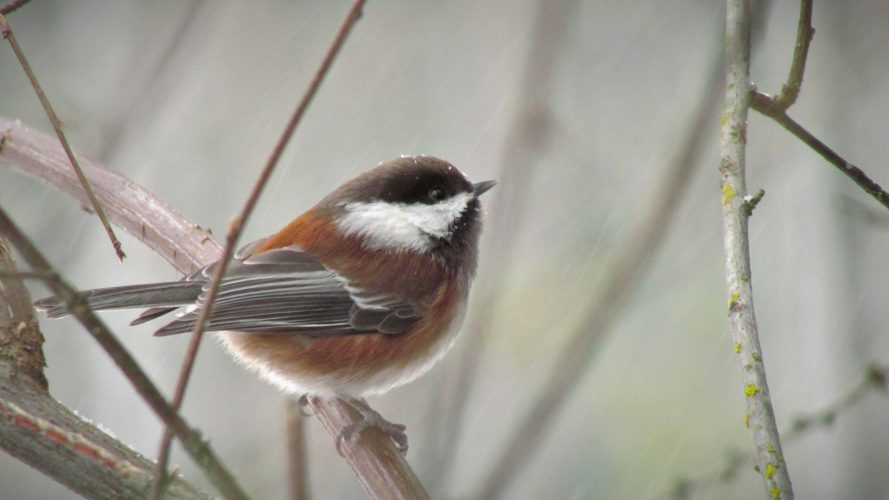
Chestnut-backed Chickadees are tiny birds with black and white on their heads, rich chestnut on the back, and gray wings and belly.
They live flocks in wet evergreen forests along the Pacific Coast and are regular visitors to backyard feeders. Insects including caterpillars, spiders, wasps, and aphids make up most of their diet, with seeds, berries, and fruit making up the rest.
You can attract Chestnut-backed Chickadees to your yard with black-oil sunflower seeds, suet, nyjer, peanuts, or mealworms in tube feeders, platform feeders, or suet cages. They will also use nest boxes.
20. Pine Siskin
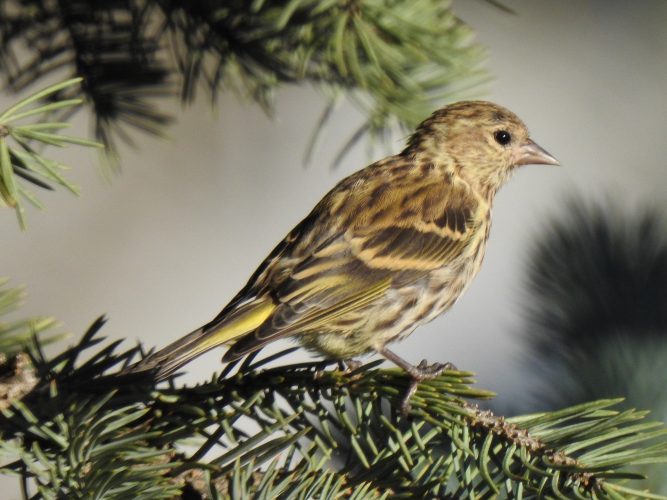
Pine Siskins are small finches that are streaked brown with yellow streaks in the wing and tail. They have a forked tail and pointed wings, with a short pointed bill.
Pine Siskins breed in Canada and can overwinter in most of the U.S, but their migration depends on pine cone crops, so some years they may not migrate. Some birds remain all year in pine forests of the west.
As their name suggests, Pine Siskins predominantly eat seeds from conifers, but they also eat young buds and seeds from grasses and weeds.
Pine Siskins can be attracted to backyards with thistle and nyjer feeders but also black oil sunflower seeds and suet.
21. Yellow-rumped Warbler

Yellow-rumped Warblers are gray with flashes of yellow on the face, sides, and rump and white in the wings. Females may be slightly brown, and winter birds are paler brown with bright yellow rumps and sides turning bright yellow and gray again in spring.
After breeding predominantly in Canada, they migrate in large numbers south across most of southern and central North America and the Pacific Coast, and throughout Mexico and Central America.
You can attract Yellow-rumped Warblers to your backyard with sunflower seeds, suet, raisins, and peanut butter.
22. Yellow warbler
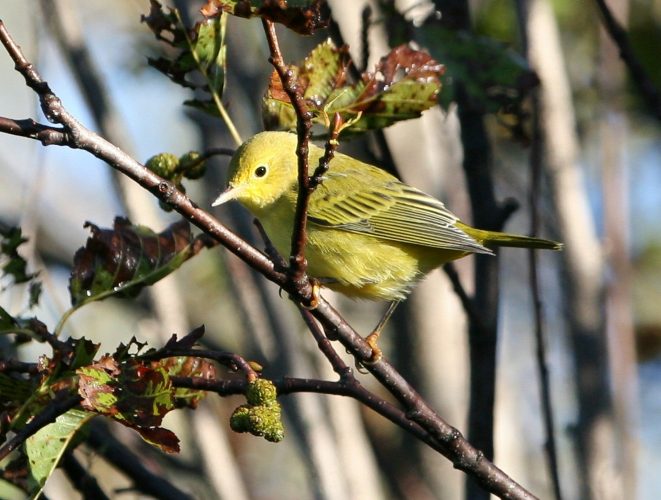
Yellow Warblers are small bright yellow birds with a yellow-green back, and the males have chestnut streaks on the breast, which are a common sight in summer.
They migrate a long-distance and breed over much of North America before heading into Central and northern South America for winter. They can be seen during migration in the far south.
Yellow Warblers can be found along streams and wetlands in thickets and along the edges of fields foraging for insects, including caterpillars, midges, beetles, bugs, and wasps.
Warblers are hard to attract to your backyard as they are shy and eat mainly insects. To attract Yellow Warblers, you can try suet, oranges, and peanut butter and plant berries and native plants that attract insects, so no pesticides or being too tidy! Birdbaths with fountains with secluded thickets nearby to provide protection.
23. Western Meadowlark
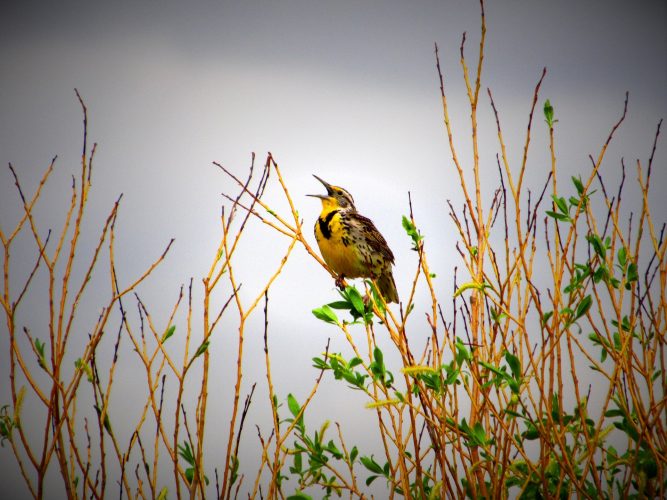
Western Meadowlarks, with their bright yellow bellies and melodious song, can brighten up your day. This is probably what makes them so popular, so popular in fact that they are the state bird of 6 states.
Western Meadowlarks are related to blackbirds and are about the size of a Robin with shades of brown and white upperparts and with a black V-shaped band across the bright yellow chest that turns gray in winter.
Breeding in northern U.S and Canada before moving to more southern states. Those in the west and midwest remain all year. Western Meadowlarks can be found foraging for insects and seeds from weeds and seeds, on the ground alone or in small flocks in grasslands, meadows, and fields.
To attract more Western Meadowlarks to your yard, try hulled sunflower seeds and cracked corn on ground feeders.
24. Chipping Sparrow
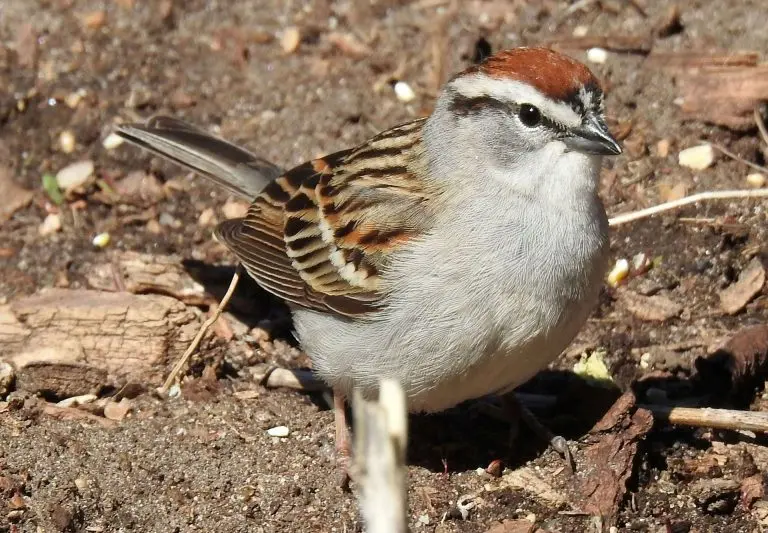
Chipping Sparrows are slender, long-tailed birds that have a grayish belly and brown and black-streaked back, with a rusty crown and black eye line. In winter, the colors are more subdued.
Breeding over much of North America and Canada, then flying to Mexico and Florida for winter. In the far south, they may remain all year. They can be found foraging on the ground for seeds and insects in grassy forests, woodlands, parks, and backyards.
They can be found in small flocks on open ground and will come to backyards for many kinds of birdseed.
25. House Wren

House Wrens are small nondescript brown birds with darker barred wings and tails and a paler throat. They breed in most states before migrating to the far south and Mexico for winter.
House Wrens can be found in backyards, parks and open woods foraging for insects, such as beetles, caterpillars, and earwigs in brush piles. House Wrens can be very aggressive over nesting sites and will harass much larger birds and even drag eggs and young out of a nest site they want.
You can attract more House Wren’s to your backyard by leaving piles of brush for them to use for protection or putting up a nest box to attract a breeding pair.
26. Mourning Dove
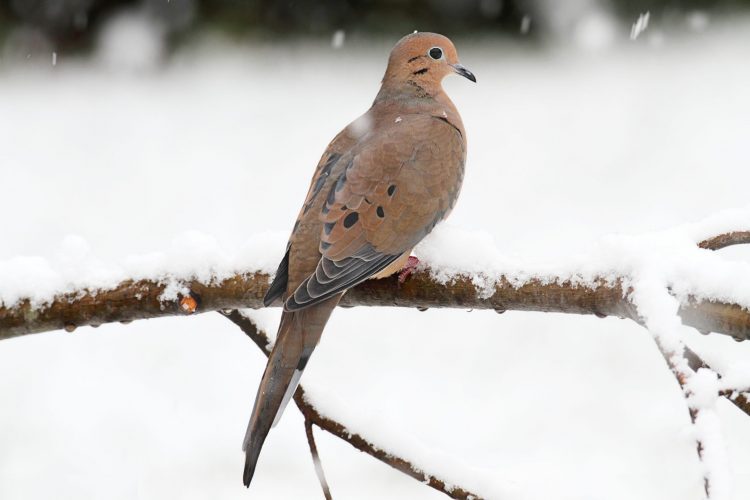
Mourning Doves are graceful small-headed birds, plump bodies and long tails. They are a soft brown with black spots on the wings.
They can be seen perching on telephone wires and foraging for seeds on the ground in grasslands, fields, and backyards. Mourning Doves can be found in open areas or on the woodland edge.
Mourning Doves are common over all of the lower 48 all year but may migrate after breeding from the far north.
You can attract more Mourning Doves to your backyard by scattering millet on the ground or on platform feeders. They will also eat black sunflower seeds, nyjer, cracked corn, and peanut hearts.
27. Downy Woodpecker
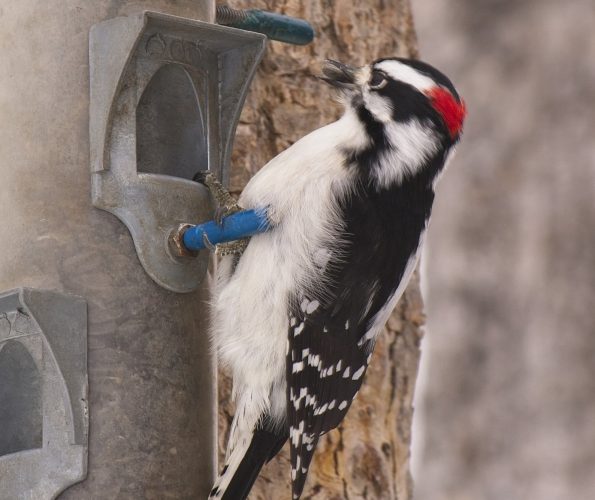
Downy Woodpeckers are small birds that are common at backyard feeders. They are often mixed in with other birds, such as chickadees and nuthatches.
They have black and white coloring with a red patch at the back of their heads. They look similar to the Hairy Woodpecker but smaller.
Downy woodpeckers can be found in woodlots, along streams, city parks, and backyards, and eat mainly insects, beetle larvae, and berries, acorns, and grains.
To attract more Downy Woodpeckers to your backyard, try suet feeders, but they will also eat black oil sunflower seeds, millet, and peanuts on platform feeders.
28. Golden-crowned Kinglet
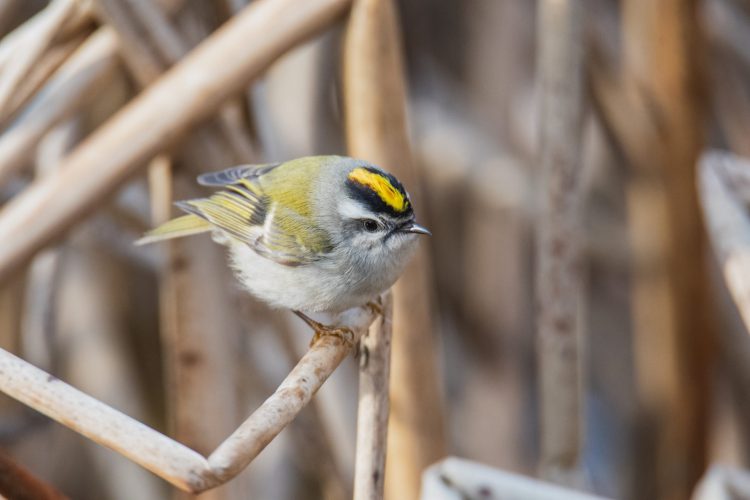
Golden-crowned Kinglets are tiny songbirds with a bright orange crown patch that can be lifted and flashed when excited. Their bodies are olive on the back and pale underneath and with a black-and-white striped face and a white wingbar.
Golden-crowned Kinglets that breed in Canada move south across all of the U.S. Some stay all year in the Appalachians and the mountainous West or Pacific Coast all the way up to Alaska stay all year.
They can be found in many habitats from forests, parks, backyards and old fields, swamps, and cities. Golden-crowned Kinglets’ diet is mainly insects, and in winter, they also eat seeds and are often hidden in dense coniferous needles.
To attract Golden-crowned Kinglets, plant native plants that encourage lots of insects and suet feeders.
29. Golden-crowned Sparrow
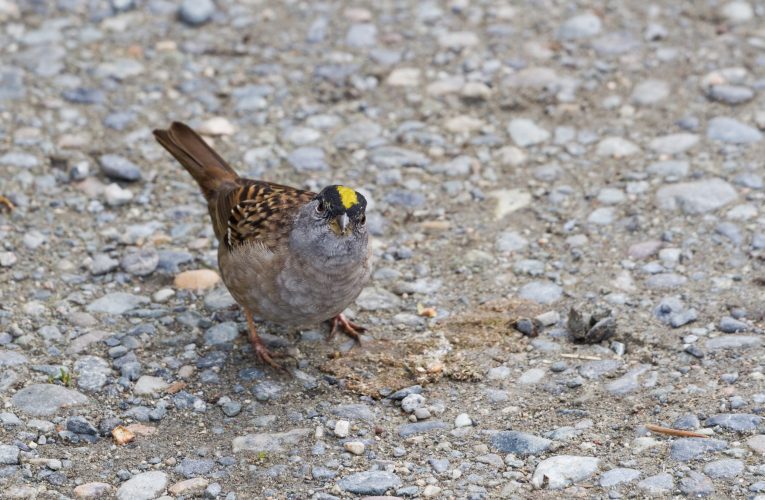
Golden-crowned Sparrows are grayish-brown underneath and streaked brown on the back. Their heads have a black crown and a bright-yellow forehead. In winter, the colors are duller with brown on the crown, and the yellow forehead is also duller.
They breed in Alaska and far western Canada before migrating to the West Coast for winter. In winter, they can be found in weedy fields scratching for seeds such as dock, sumac, and geranium, and they also eat fruit such as apple, grape, elderberry, and olives. Insects also make up some of their diets, such as ants, beetles, butterflies, and termites.
You can attract more Golden-crowned Sparrows to your backyard with seeds in ground feeders or plant native plants that fruit.
30. Lesser goldfinch
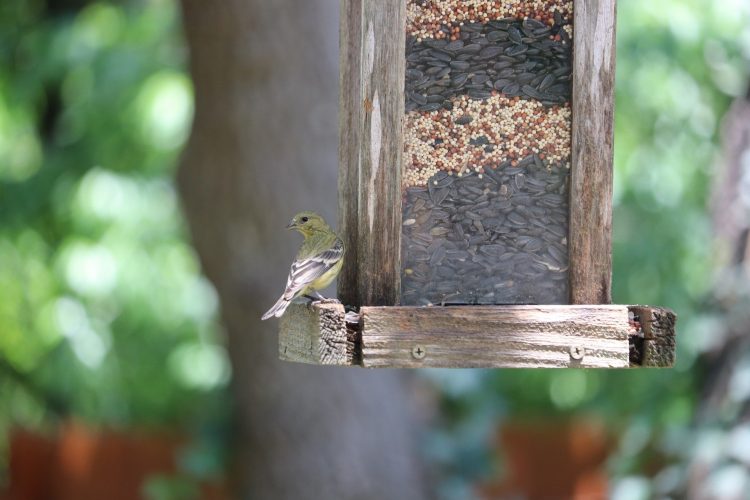
Lesser Goldfinches are tiny bright yellow and black songbirds with long pointed wings and short notched tails. Females have olive backs and are more dull yellow underneath.
Residents in the far southwest, with those to the north of their range breeding then migrating further south.
Lesser Goldfinches can be found in large flocks in open habitats, including thickets, weedy fields, forest clearings parks, and gardens. They forage for seeds, especially sunflower seeds, and fruits from elderberry, coffeeberry, and buds from cottonwoods, willows, sycamores, and alders.
You can attract more Lesser Goldfinches to your yard with sunflower seeds and nyjer in tube feeders or platform feeders.
31. Ruby-crowned Kinglet
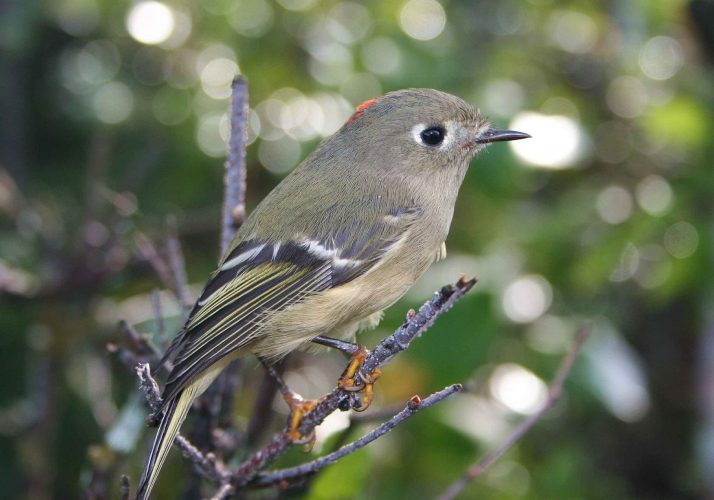
Ruby-crowned Kinglets are small songbirds that are olive-green, and the males have a brilliant red crown that is usually flat so hard to see, but great if you do.
They breed across Canada and the western mountains before migrating to southern and southwestern states and Mexico for the winter. They can also be seen during migration when they are widespread.
Ruby-crowned Kinglets can be hard to spot, and they are fast-moving quiet birds that flit around in the foliage of lower branches and of shrubs and trees looking for spiders and insects.
They come to suet feeders or platform feeders for hulled sunflower seeds, peanut hearts, and mealworms.
32. Steller’s Jay
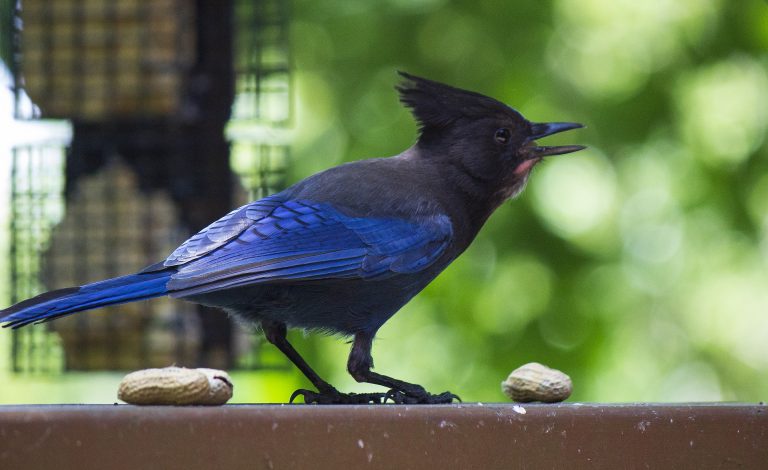
Steller’s Jays are large songbirds with black triangular crests that stick up from their heads. The rest of their heads and onto their chests and back are black, with the rest of their bodies being blue.
They can be found in evergreen forests in the mountains, and they will also be found around picnic tables, campgrounds, and backyard feeders. They make nests out of the mud.
Stellar’s Jays eat most things they can forage for, including insects, seeds, nuts, berries, eggs, and nestlings, but also making a nuisance of themselves around garbage and your unguarded picnic!
Stellar’s Jays can be attracted to your backyard with peanuts and suet.
33. Common Yellowthroat
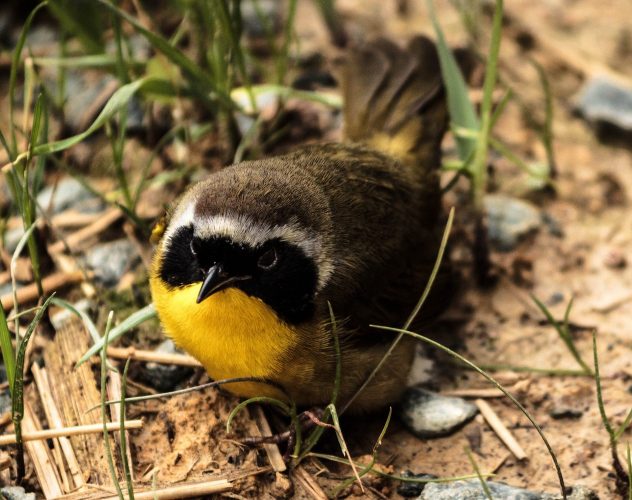
Common Yellowthroats are small songbirds that are brownish on the back and bright yellow underneath, with long tails. The males have a black mask across their face. The brightness of the yellow can vary geographically, and they may be more olive in parts underneath.
They breed over much of North America and so can be found in the spring and summer, often in marshy or wetland areas and brushy fields living in thick, tangled vegetation. They eat insects primarily and will be found in large backyards with dense vegetation.
34. Western Tanager

Western Tanagers have a flaming orange-red head, yellow body, and black wings. They can be found all over western states breeding towards the north and then migrating south for winter.
They live in open conifer forests but stay hidden in the canopy, despite their bright coloring. The red color probably comes from eating insects that produce a pigment that the Western Tanagers cannot produce themselves.
You can attract Western Tanagers with dried fruit, cut oranges, and other fruits from bird feeders.
Best Bird Feeders to Attract Birds in The Pacific Northwest
A variety of different bird feeders will attract the most species of birds
- Tube Feeders can be filled with different types of birdseed and depending on the seed different birds will be attracted. Black oil sunflower seeds attract Goldfinches, Chickadees, Woodpeckers, Nuthatches, and Pine Siskins.
- Ground Feeders or a tray below a Tube Feeder with Black oil sunflowers tube feeders attract Cardinals, Jays, Finches, and Sparrows.
- Platform feeders with Millet or Corn attract small and medium-sized birds such as sparrows, Blackbirds, Towhees, Juncos, Doves, Grackles, and Starlings.
- Peanut feeders attract Woodpeckers, Chickadees, Nuthatches, Titmice, Jays, Juncos, Finches, and Sparrows.
- Suet Feeders are great, especially in winter, for Woodpeckers, Cardinals, Nuthatches, Kinglets, Wrens, and Chickadees.
- Hummingbird feeders attract these tiny fascinating birds but they also attract other birds too.
How to Attract Birds to Your Yard in The Pacific Northwest
If you would like to attract more birds to your yard in British Columbia there are some tips:
- Provide bird feeders for different types of birds to get the most species to visit your yard.
- Provide a water feature such as a birdbath fountain or stream. Ensure that the water is clean and not stagnant
- Grow native plants that will provide food and shelter. Plants, trees, and shrubs that provide fruit, berries, and nuts. Blackberries, wild grasses, elderberries, serviceberries, Oaks, Beeches, Cherries, sumacs, hemlocks, Purple Coneflowers, Sunflowers, Milkweed, Cardinal Flowers, Trumpet Honeysuckle, Virginia Creeper, Buttonbush, and Dogwoods.
- Let your grass grow long to provide cover and seeds.
- Leave a brush pile to provide food, protection, and nesting opportunities for birds.
- Don’t use pesticides and herbicides as these may be toxic to birds and prevent the natural foraging opportunities for insects and seeds that birds will seek in your yard.
- Set up nest boxes to attract breeding birds and ensure they are cleaned every year.
How to Identify Birds in The Pacific Northwest
Here are some tips to help you identify birds:
- Size – Size is the easiest thing to notice about a bird. Birds are often measured in inches or centimeters in guide books. It’s best to take a note of the bird in terms of small, medium, or large to be able to look for it later. A small bird is about the size of a sparrow, a medium bird is about the size of a pigeon and a large bird is the size of a goose.
- Shape – Take note of the silhouette of the bird and jot it down or draw the outline. Look at tail length, bill shape, wing shape, and overall body shape.
- Color pattern – Take a note of the main color of the head, back, belly, and wings, and tail for the main color and then any secondary colors or patterns. Also take note of any patterns such as banding, spots, or highlights.
- Behavior – Are they on the ground or high up in the trees. Are they in flocks or on their own? Can you spot what they are eating?
- Habitat – Woodlands, parks, shrubs, grasslands or meadows, shore or marsh.
- Use a bird identification app such as those created by ebird or Audubon
